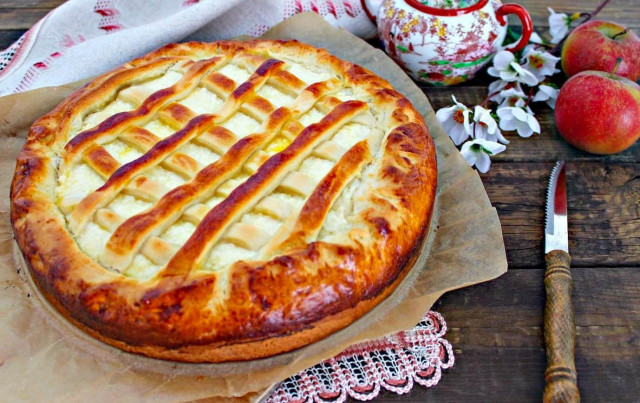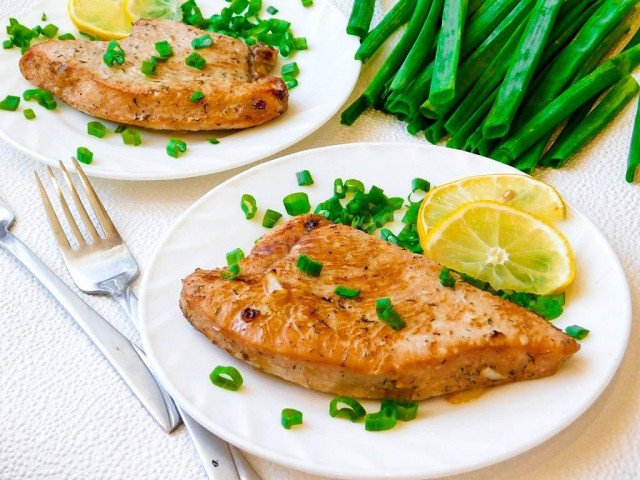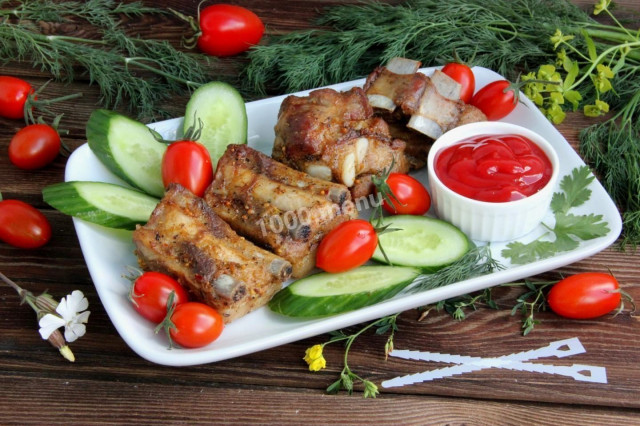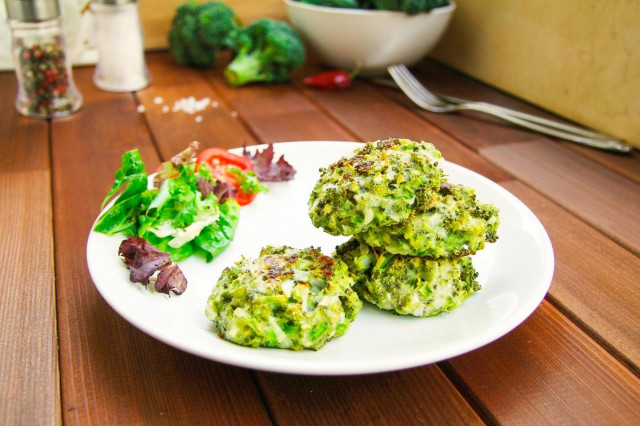Composition / ingredients
Step-by-step cooking
Step 1:
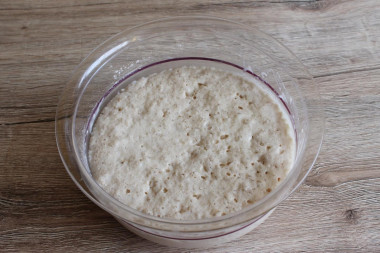
How to make a pie from yeast dough with cottage cheese in the oven? First of all, prepare the sourdough. Pour warm milk into a large bowl, its temperature should be about 38 degrees, no more, otherwise yeast will die. Pour yeast into the milk, add a spoonful of sugar and 4 tablespoons of flour. Mix the sourdough well, cover the bowl with a towel and let it stand for half an hour. That's about how it should rise. When the sourdough begins to descend, it is ready to work.
Step 2:
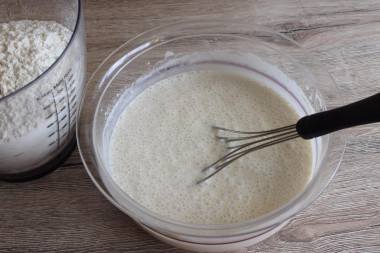
As soon as this happens, add the melted butter, salt and remaining sugar to the sourdough. Mix the mass with a whisk. Read about how you can melt butter in different ways at the end of the recipe. Choose high-quality, natural butter for the dough, without vegetable fats.
Step 3:

Add the sifted flour in portions and knead the dough. Be prepared for the fact that flour may need more or less than indicated in the recipe. Focus not on the amount of flour, but on the desired consistency of the dough. It should become smooth, homogeneous and not sticky. Assemble the dough into a ball, put it in a bowl, cover it with a towel. Put the dough in a warm place without drafts for an hour to rise.
Step 4:

While the dough is rising, prepare the filling. Choose natural cottage cheese for her, the higher the fat content, the tastier the pie will turn out. If your cottage cheese is coarse, then punch it with a blender or rub it through a sieve, so the filling will turn out more tender. Beat the eggs into the cottage cheese, be sure to wash them well before that. Add sugar and semolina. Stir until smooth and leave until the dough rises completely.
Step 5:

The dough should double during this time. Put it on the table, sprinkled with flour. Roll out with a rolling pin into a layer 1 cm thick.
Step 6:

I took a detachable mold with a diameter of 26cm. The bottom was covered with baking paper. Cut a circle out of the dough, a little more than 26 cm. And put it in a mold, form the sides.
Step 7:
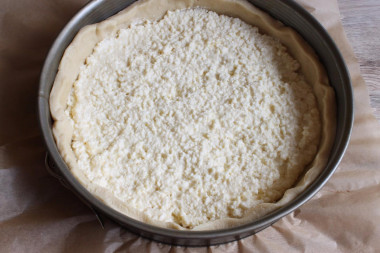
Put the curd filling on the dough. Smooth it out with a spoon. Cut strips from the remaining dough.
Step 8:
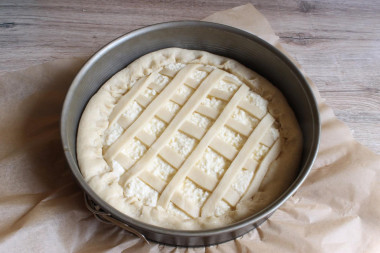
Lay out the strips on top in the form of a mesh, lower the sides from above and pinch the edges. Cover the pie with a towel and leave to come up for 30 minutes.
Step 9:
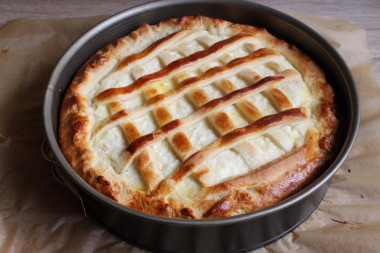
Preheat the oven to 180°C. Brush the top of the cake with lightly beaten yolk, then it will brown well when baking. Put the pie to bake for 30-40 minutes. The baking time depends on the characteristics of your oven, focus on the appearance of the pie. Take it out and let it cool down a bit. Then carefully open the mold and take out the pie on a platter.
Step 10:

Serve the pie warm or cold, it is delicious in any form. Serve tea or milk with the pie. Bon appetit!
Butter can be melted in the microwave or in a water bath.
How to melt butter in the microwave?
Cut the butter into small pieces and place it in a special container. To prevent the oil from splashing when heated, cover the oil vessel with a paper towel. The oil should be melted either at the lowest power or in defrosting mode. At first, five seconds will be enough. Next, if the butter has not melted yet, set it again for 5 seconds and start the microwave. Repeat the process several times until the desired result.
How to melt butter in a water bath?
You will need two containers of different diameters. Pour water into a large one and put it on the stove. Place the smaller container on top so that it is submerged in water by about half. Put the sliced butter into it. Under the influence of boiling water, the oil will begin to melt. Stir the oil slightly to speed up the process. As soon as the pieces of oil are completely dissolved, remove the container from the stove.
Important! Using dry yeast, it should be borne in mind that they occur in two forms: active and instant (read the instructions carefully before use!).
Active dry yeast looks like beads or small balls. Before applying them, they must be brought out of "sleep mode". To do this, the active yeast is diluted in warm sweet water, milk or whey. The resulting bubbles, foam or "cap" indicate that the yeast is ready for further use. Active dry yeast must be brought to complete dissolution in the liquid, otherwise, due to the remaining grains, the dough may not rise and the baking will be spoiled (yeast grains that have not dissolved in the liquid and got into the dough will not disperse on their own, which means they will not work).
Instant dry yeast is easier to use. They do not need to be activated before use. Such yeast, along with other ingredients, is simply added to the dough. As a result, the baking time is reduced.
It should also be remembered that both types of dry yeast may differ in their activity from different manufacturers.
It is important to sift the flour to saturate it with oxygen. Then the baking will turn out to be airy and will rise well when baking.
Caloric content of the products possible in the composition of the dish
- Whole cow's milk - 68 kcal/100g
- Milk 3.5% fat content - 64 kcal/100g
- Milk 3.2% fat content - 60 kcal/100g
- Milk 1.5% fat content - 47 kcal/100g
- Concentrated milk 7.5% fat content - 140 kcal/100g
- Milk 2.5% fat content - 54 kcal/100g
- Chicken egg - 157 kcal/100g
- Egg white - 45 kcal/100g
- Egg powder - 542 kcal/100g
- Egg yolk - 352 kcal/100g
- Ostrich egg - 118 kcal/100g
- Semolina - 340 kcal/100g
- Cottage cheese of 40% fat content - 466 kcal/100g
- Cottage cheese of 20% fat content - 233 kcal/100g
- Cottage cheese of 18% fat content - 226 kcal/100g
- Cottage cheese of 10% fat content - 156 kcal/100g
- Low-fat cottage cheese - 75 kcal/100g
- Cottage cheese with sour cream - 260 kcal/100g
- Fruit cottage cheese - 147 kcal/100g
- Soft dietary cottage cheese - 170 kcal/100g
- Vitalinia cottage cheese - 64 kcal/100g
- Cottage cheese "morning" ( "danone") without sugar - 91 kcal/100g
- Cottage cheese - 156 kcal/100g
- Whole durum wheat flour fortified - 333 kcal/100g
- Whole durum wheat flour, universal - 364 kcal/100g
- Flour krupchatka - 348 kcal/100g
- Flour - 325 kcal/100g
- Granulated sugar - 398 kcal/100g
- Sugar - 398 kcal/100g
- Butter 82% - 734 kcal/100g
- Amateur unsalted butter - 709 kcal/100g
- Unsalted peasant butter - 661 kcal/100g
- Peasant salted butter - 652 kcal/100g
- Melted butter - 869 kcal/100g
- Salt - 0 kcal/100g
- Vanilla sugar - 379 kcal/100g
- Dry yeast - 410 kcal/100g

